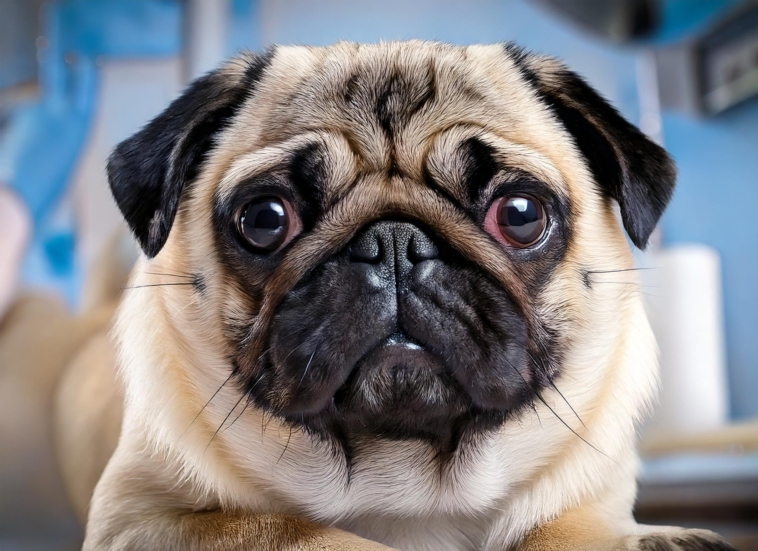Comprehensive Guide to Common Health Issues in Pugs
Pugs are idolized for their playful, cute nature. However, their peculiar physical characteristics pose them towards various health challenges. Knowledge about these health concerns is important for pug owners who will endeavor to ensure that their furry friends live a long happy and comfortable life.
Common Health Risks in Pugs
The pugs have a number of health problems, most of them connected with their genetic code and body structure. The most common include:
Brachycephalic Obstructive Airway Syndrome (BOAS)
- Hip Dysplasia
- Skin Conditions
- Eye Diseases
- Obesity
Regular veterinary check-ups are very important for early diagnosis and treatment. Preventive care not only improves a pug’s life, but it helps to care for potential health associated with the particular breed before they become serious issues.
The Importance of Understanding Health Issues in Pug
Pugs are certainly non-generic, and their loveliest parts may also become reasons for health complications.
- Broad Skull: This leads to breathing problem with a nasal structure being compressed.
- Prominent Eyes: Their big and protruding eyes are liable to get injured and infected.
- Wrinkled Skin: Deeply settled folds of the face make conditions most suitable for bacterial and fungal infections.
- Compact Body: Their short, stocky build is associated with an increased threat of joint and spine complications.
- Curly Tail: This can on some occasions be associated with spinal malformations like hemivertebrae.
Identifying these traits gives owners an opportunity to expect possible problems and take initiatives with the aim of prevention and treatment.
Respiratory Issues in Pugs
Common Conditions:
- Tracheal Collapse: Symptoms are in form of honking cough, fatigue and difficulty breathing.
- Elongated Soft Palate: May lead to snoring, gagging, and laboring breathing.
Management Tips:
- Weight Control: Being in normal weigh facilitates minimizing the pressure over the airways.
- Avoid Overheating: Pugs are heat-sensitive. Place them in cool environments and discourage them from causing unnecessary activity when they are in hot places.
- Clean Air: Limit the exposure to smoke, strong scents and pollutants.
- Regular Vet Visits: There is need for early intervention in addressing respiratory problems.
Skin Diseases and Allergies
The wrinkly skin of the pugs and their short coats make them prone to various skin problems.
Prevention and Treatment:
- Routine Cleaning: Clean skin folds on a regular basis to avoid infections.
- Flea & Tick Control: Apply vet recommended preventatives to prevent infestations.
- Allergy Management: Conduct allergen identification and avoidance with your vet.

Eye Problems or Health Issues in Pug
Taking into consideration their facial anatomy, pugs are highly prone to eye disorders.
Common Conditions:
- Corneal Ulcers: May lead to loss of vision due to dry eyes or injury.
- Cherry Eye: Prolapse of a tear gland – usually treated by surgery.
- Entropion: Inward-rolling eyelids irritate the cornea.
Progressive Retinal Atrophy (PRA): A disease of degenerative nature which can result in blindness.
Eye Care Tips:
- Routine Vet Exams: Early detection can save long-term damage.
- Eye Hygiene: Use vet-approved wipes and cleansers.
- Limit Exposure: Avoid getting in contact with dust and bright UV light.
- Watch for Symptoms: Redness, discharge, squinting or alteration of the appearance of eyes call for immediate attention.
Joint and Mobility Problems
The stout construction of pugs is related to a number of orthopedic problems.
Common Conditions:
- Patellar Luxation: Limb or hopping due to dislocation of the kneecap.
- Degenerative Myelopathy: A progressive disorder of the spinal cord involving the strength of hind limbs.
Maintenance and Prevention:
- Weight Management: High weight puts a strain on the Joints.
- Balanced Diet: Contain omega-3 and supplements for joint (e.g., glucosamine).
- Moderate Exercise: Nice exercise such as walking or swimming helps to preserve mobility.
- Soft Bedding: Reduces joint pressure during rest.
Obesity in Pugs
Obesity is a serious problem in pugs and can further complicate other health problems.
Healthy Feeding Guidelines:
- High-Quality Dog Food: Do not eat leftover food and fatty treats.
- Portion Control: Weigh food and do not deviate from a schedule.
- Physical Activity: There is a need for daily walk and play.
Monitoring:
- Regular Weigh-Ins: Keep track of their weight.
- Vet Guidance: Speak on dietary plans and scan for underlying conditions if weight gain continues.
Dental Health
Dental diseases especially periodontal are common to pugs.
Prevention:
- Daily Brushing: Use dog-specific toothpaste and toothbrushes.
- Annual Dental Cleanings: Professional cleanings assist in prevention of tartar accumulation.
- Vet-Prescribed Dental Diets: These can help to eliminate plaque and tartar.
Signs of Dental Problems and Health Issues in Pug:
Bad breath, bleeding in gums, not wanting to bother eating, and the emergence of tartar on the teeth.
- Vaccination and Routine Health Monitoring
- Pugs require regular care to help avoid disease and catch anything early.
Routine Exams Should Include:
- Blood work
- Urinalysis
- Eye and ear checks
- Skin and dental evaluations
- Essential Puppy Vaccinations:
- Distemper
- Parvovirus
- Rabies
Booster shots and deworming programmers from time to time must also be maintained throughout life.
Preventive Health Toolkit for Pugs
- Dental Care: Brushing, chew toys and dental treats on a daily basis.
- Routine Tests: Yearly blood work, urinalysis, and wellness exam.
- Parasite Control: Monthly flea, tick and heartworm prevention drugs.
- Proper Hygiene: Regular clean-up of folds, ears as well as paws.
Environmental and Lifestyle Needs
A constructive lifestyle is important for health of Pug:
- Temperature Control: Prevent from overheating; use cooling mats or shade areas.
- Clean Water: Always have fresh water available.
- Mental Stimulation: Games and toys as well as interaction with people avoid boredom.
- Comfortable Sleep: Use soft, joint-friendly bedding.
Conclusion
The pug is a cuddly and loving little friend but requires careful attention because of its special personality. Getting to know their particular health weaknesses and avoiding the complacency by visiting the vets regularly and ensuring proper nutrition and changes in lifestyles, pugs owners will be providing for their furry friends a lengthy, enjoyable, and healthy life.




